Paschal troparion
The Paschal troparion or Christos anesti (Greek: Χριστὸς ἀνέστη) is the characteristic hymn for the celebration of the Orthodox Pascha (Easter) in the Eastern Orthodox Church and churches that follow the Byzantine Rite.
Like most troparia it is a brief stanza often used as a refrain between the verses of a Psalm, but is also used on its own. Its authorship is unknown, though it has been attributed to Romanos the Melodist. It is sung in the first plagal (or fifth) tone. It is often chanted thrice (three times in succession).
Usage
The troparion is first sung at the beginning of Matins on Pascha, following the procession around the church which precedes Matins. When all are gathered before the church's closed front door, the clergy and faithful take turns chanting the troparion, and then it is used as a refrain to a selection of verses from Psalms 67 and 117 (this is the Septuagint numbering; the KJV numbering is 68 and 118):
Let God arise, let His enemies be scattered; let those who hate Him flee from before His face (Ps. 68:1)
As smoke vanishes, so let them vanish; as wax melts before the fire (Ps. 68:2a)
So the sinners will perish before the face of God; but let the righteous be glad (Ps. 68:2b)
This is the day which the Lord hath made, let us rejoice and be glad in it. (Ps. 118:24)
In the remainder of the Vigil it is sung after each ode of the canon, at the end of the Paschal stichera at the Aposticha, thrice at the dismissal of Matins, and at the beginning and end of the Paschal Hours. It is chanted again with the same selection of Psalm verses at the beginning of the Divine Liturgy, at the Little Entrance, during and following Communion, and at the dismissal of the Liturgy. It is then chanted again with the refrains at the beginning of Vespers, and at the dismissal of Vespers. This same pattern persists throughout Bright Week.
Beginning on Thomas Sunday (the Sunday after Pascha), it is either sung or read thrice at the beginning of most services and private prayers in place of the usual invocation of the Holy Spirit, "O Heavenly King", and at the dismissals, during the 39-day paschal afterfeast; that is, up to and including the day before the Ascension of the Lord.
Text
The troparion was originally composed in Koine Greek, but it is usually sung either in the local liturgical language, or in the vernacular where it is not the same. In recent years, the custom has developed of chanting the Paschal troparion in a number of different languages.
| Greek | Typical English Translation |
|---|---|
Χριστὸς ἀνέστη ἐκ νεκρῶν, θανάτῳ θάνατον πατήσας, καὶ τοῖς ἐν τοῖς μνήμασι, ζωὴν χαρισάμενος! Transliteration: Christós anésti ek nekrón, thanáto thánaton patísas, ké tís en tís mnímasi, zoín charisámenos! | Christ is risen from the dead, by death conquering death, and to those in the tombs granting life! |
Other languages
In multicultural Orthodox parishes and communities, during the Paschal Vigil and during Vespers the following afternoon, it is not uncommon for the troparion to be performed in as many languages as are represented in the parish or as the choir can manage. This is to share the universal aspect of the Paschal Troparion for all of humanity.
| Language | Translation | Transliteration |
|---|---|---|
| Hebrew | המשיח קם מבין המתים רמס מות במותו וחיים למתים נתן |  |
Usage in the Evangelical Lutheran Church of Finland
In Finland, the Orthodox Church of Finland is a minority church. However, the Orthodox Easter night has, for many decades, been broadcast annually on radio and television, and thus the troparion has gradually become well-known to non-Orthodox Finns. In 1986, the Evangelical Lutheran Church of Finland - the largest religious denomination in the country - included the troparion in its revised official hymn book, where it is hymn number 90, as an Easter hymn. It is recommended to be sung three times in succession.[1]
External links
- Paschal troparion in Greek sung by monks from Valaam Monastery
- Paschal troparion in Church Slavonic sung by monks of Kievsko-Pecherska Lavra in Ukraine
- Paschal troparion in Polish sung by the choir of the orthodox chapel in Warsaw (Poland)
- Paschal troparion in Greek sung by nuns from St. Mary and Martha's Monastery at Święta Góra Grabarka in Poland
- Paschal Troparion
- Paschal troparion arrangement for symphonic orchestra by Nicolas Astrinidis
- Paschal Troparion - Christ is Risen in English and Slavonic and Greek English transliteration
- Paschal Troparion in transliteration
- Orthodox Church of America Pascha Music Downloads
- Paschal Troparion in Four Languages with music
- NATIONAL FORUM of GREEK ORTHODOX CHURCH MUSICIANS